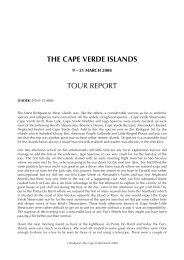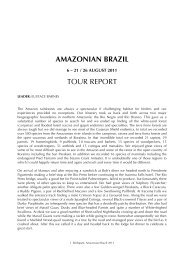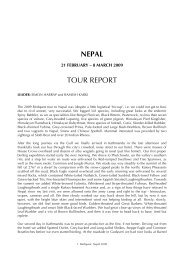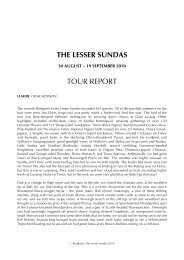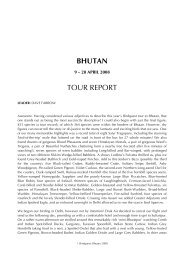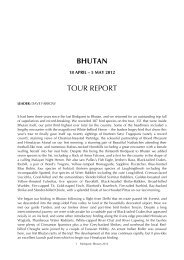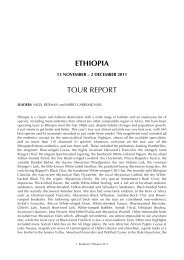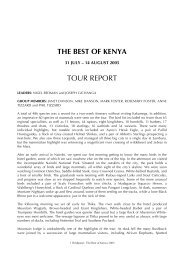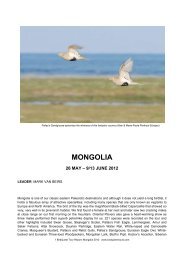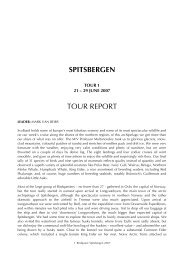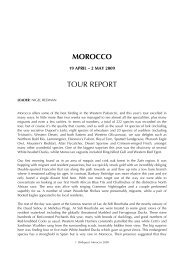Download Full Tour Report 1202kb - Birdquest
Download Full Tour Report 1202kb - Birdquest
Download Full Tour Report 1202kb - Birdquest
Create successful ePaper yourself
Turn your PDF publications into a flip-book with our unique Google optimized e-Paper software.
White-browed Hermit Phaethornis stuarti: This speciality was first seen near Pilcopata by Richard<br />
and the leader with a second seen by others at Amazonía Lodge.<br />
White-bearded Hermit Phaethornis hispidus: Seen well on several occasions, this species was a<br />
regular at the Manu Wildlife Centre feeders.<br />
Koepcke’s Hermit Phaethornis koepckeae: Great views near the clearing at Amazonía Lodge. A<br />
Peruvian endemic, classified as Near-Threatened, and named after Maria Koepcke, who<br />
wrote the Dept. of Lima field guide and died in a plane crash along with 92 others in<br />
1971. One of the sole survivors was her 17-year old daughter brought back in the rescue<br />
mission. An enthusiastic explorer and ornithological curator for the Lima museum, one of<br />
Koepcke’s most important discoveries was a new species, endemic to Peru from the<br />
highland forests of Zarate, the White-cheeked Cotinga, Zaratornis stresemanni. From Peru<br />
she described three species of birds new to science and 13 new subspecies. In addition to<br />
the hermit bearing her name, the endemic Selva Cacique, Cacicus koepckeae and the<br />
Peruvian subspecies of Horned Curassow, Pauxi unicornis koepckeae were named in her<br />
honour. A bat, Mimon koepckeae and a lizard, Tropidurus occipitalis koepckeorum, are<br />
also named after her.<br />
Needle-billed Hermit Phaethornis philippii: One showed briefly to us in hovering flight at Manu<br />
Wildlife Centre.<br />
Wedge-billed Hermit Schistes geoffroyi: We eventually all had good views of this species in the<br />
garden at Cock-of-the-Rock Lodge.<br />
Green Violetear Colibri thalassinus: Three were seen in the Manu cloud forest and at least two more<br />
were seen in the Aguas Calientes area during the extension.<br />
Sparkling Violetear Colibri coruscans: At least three were regularly visiting the feeders in the cloud<br />
forest.<br />
Black-throated Mango Anthracothorax nigricollis: One showed nicely at Amazonía Lodge.<br />
Amethyst-throated Sunangel Heliangelus amethysticollis: We had excellent views of this<br />
hummingbird along the trail below Waqanki station.<br />
Rufous-crested Coquette Lophornis delattrei: We had brilliant close-ups of female plumaged birds at<br />
Amazonía, but no sign of the males during our visit.<br />
Festive Coquette Lophornis chalybeus: This species is now fairly regular visiting the vervain at Manu<br />
Wildlife Centre where we saw first a female followed the next day with a cracking male.<br />
Peruvian Piedtail Phlogophilus harterti: In the lower cloud forest we all had excellent views of male<br />
birds at their lek.<br />
Speckled Hummingbird Adelomyia melanogenys: Somewhat common around Cock-of-the-Rock<br />
Lodge, this cloud forest hummingbird is reminiscent of a hermit hummingbird in<br />
appearance.<br />
Long-tailed Sylph Aglaiocercus kingi: Several sightings of both male and female birds. Named after<br />
Rear Admiral Philip Parker King (1791-1856), British marine surveyor, collector and<br />
traveller in the American tropics.<br />
Green-tailed Trainbearer Lesbia nuna: We had just one good sighting in the arid scrub around<br />
Huacarpay Lake.<br />
Bearded Mountaineer Oreonympha nobilis: A restricted-range, Peruvian endemic who performed<br />
wonderfully in an area of Nicotiana sp. (‘tree tobacco’). Our sighting of two duelling<br />
males and their iridescent beards was really special! ‘Restricted-range’ is defined by<br />
Birdlife International as a species confined to an area of less than 50,000 square<br />
kilometres. Peru has the highest number of restricted-range species in the Neotropics and<br />
is second in the world only to Indonesia.<br />
Tyrian Metaltail Metallura tyrianthina: Both males and females were seen well foraging in the area of<br />
Pillahuata, here of the deep blue-tailed race smaragdinicollis.<br />
Gould’s Inca Coeligena inca: We had just one decent sighting on our second day in the Manu cloud<br />
forest.<br />
Violet-throated Starfrontlet Coeligena violifer: In all we saw three of this large hummer in the Manu<br />
cloud forest.<br />
20 <strong>Birdquest</strong>: The Manu 20011




